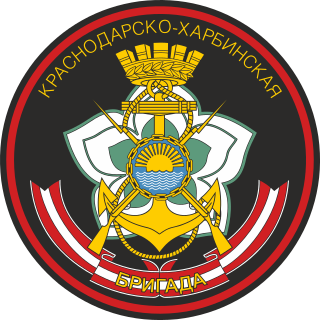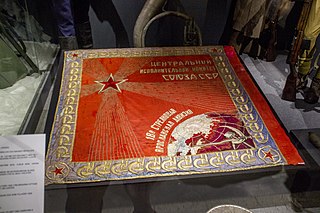The 2nd Rifle Division was a rifle division of the Red Army that served from the Russian Civil War to the Second World War. Originally formed in 1919 from the 1st Ryazansk Rifle Division, the division was twice destroyed and reformed during the war. The division contained two or three rifle regiments.
The 1st Red Banner Army was a Red Army field army of World War II that served in the Soviet Far East.

The 38th Separate Guards Vitebskaya order of Lenin Red Banner order of Suvorov Motor Rifle Brigade is a mechanized infantry brigade of the Russian Ground Forces, part of the Eastern Military District. Military Unit в/ч 21720.
The 78th Rifle Division was an infantry division of the Red Army, formed in 1932, in Novosibirsk, in the Siberian Military District. After being used to provide cadres for new divisions, in September 1939 the division was reformed for the second time. In 1940 the division was transferred to Khabarovsk in the Far Eastern Front.
The 101st Rifle Division was a unit of the Soviet Red Army initially formed as a mountain rifle division on 28 August 1938 within the 2nd Separate Red Banner Army in Petropavlovsk-Kamchatsky city.

The 10th Guards Motor Rifle Division was a division of the Soviet Ground Forces. The full name of its predecessor division was the 10th Guards Rifle Pechengskii, Twice Order of the Red Banner, Order of Alexander Nevsky, Order of the Red Star Division. The 10th Guards Rifle Division was formed from the 52nd Rifle Division in late 1941.
The 15th Rifle Division was a military formation of the Red Army formed by renaming the Red Army's Inza Revolutionary Division on 30 April 1919. The division was active during the Russian Civil War and World War II.

The 28th Army was a field army of the Red Army and the Soviet Ground Forces, formed three times in 1941–42 and active during the postwar period for many years in the Belorussian Military District.

The 40th Independent Krasnodarsko-Kharbinsky Twice Red Banner Marine Brigade is a brigade of the Russian Marines. It is based in Petropavlovsk-Kamchatskiy in the Russian Far East and has the Military Unit Number (v/ch) 10103. It is part of the North-East Group of Troops and Forces, a joint command directed by the headquarters of the Navy's Kamchatka Flotilla.
The 266th Rifle Division was a rifle division of the Soviet Red Army during World War II. The 266th was formed three times during the war.
The 55th Guards Rifle Division was a Red Army military unit, engaged in the Second World War. Its full name was the 55th Guards Rifle Irkutsk-Pinsk Order of Lenin, Order of the October Revolution, three Red Banner, Order of Suvorov 2nd degree division named after the Supreme Soviet of the RSFSR.

The 18th Rifle Division was an infantry division of the Soviet Union's Red Army during the Russian Civil War, Polish–Soviet War, Winter War and World War II. The division was formed a total of five times during this period.
The 69th Rifle Division was an infantry division of the Red Army and later the Soviet Army, formed twice.
The 207th Rifle Division began its combat path under unusual circumstances. It was partly formed for the first time as a standard Red Army rifle division in the spring of 1941, before the German invasion, but was never completed. A second formation began in April 1942 and was completed on June 1, after which it was sent to the Stalingrad Front. Heavily depleted in counterattacks against the north flank of German Sixth Army, by November the survivors were reassigned and the division disbanded. The 207th was formed for a third time in June 1943, and fought its way through the central part of the Soviet-German front, ending the war in the heart of Berlin in the battle for the Reichstag. The division saw postwar service in the Group of Soviet Forces in Germany.
The 47th Rifle Division was an infantry division of the Red Army. It was first formed in 1922 as the Georgian Rifle Division. In 1924, it became the 1st Georgian Mountain Division. The division became the 47th Georgian Mountain Rifle Division in 1936 and dropped the designation "Georgian" in 1940. It was disbanded in June 1942 after being wiped out at Izyum. In July 1942, the 47th Rifle Division was formed from the 21st Rifle Brigade. It fought in the Nevel Offensive, for which it was awarded the title "Nevel". The division was disbanded in the Baltic Military District in 1946. It was also awarded the Order of Lenin and the Order of Suvorov 2nd class. The division was reformed a third time from the 277th Rifle Division in 1955 but disbanded in July 1956.
The 341st Rifle Division was first formed in September 1941, as a standard Red Army rifle division, at Stalingrad. It was a "sister" unit to the 335th Rifle Division, which was formed at about the same time and place and shared a very similar combat path in its first formation. It was assigned to the southern sector of the Soviet-German front during the winter counteroffensive, but was effectively destroyed during the German spring offensive that formed the Izium Pocket, and was soon disbanded. The division was formed again almost exactly two years later, this time in the Karelian Front, facing Finland, and saw only limited action in the Continuation War before being assigned to coastal defense duties during 1945. The 341st Rifle Division continued to serve well into the Cold War, eventually being re-designated and becoming a motorized rifle division.
The 59th Rifle Division was an infantry division of the Red Army and briefly of the Soviet Army.
The 363rd Rifle Division formed in August 1941, as a standard Red Army rifle division, in the Sverdlovsk Oblast. It may be considered a "sister" division to the 361st Rifle Division. After forming, it was assigned to the 30th Army, and played a role in the near-encirclement of the German 9th Army around Rzhev in the winter counteroffensive of 1941-42. In recognition of its tactical successes it was reorganized as the 22nd Guards Rifle Division in March 1942. A new 363rd was formed in November 1944, in the far east of the USSR. It saw very limited action during the Soviet invasion of Manchuria in August 1945, primarily in a pursuit and exploitation role.
The 365th Rifle Division began forming on 1 September 1941, as a standard Red Army rifle division, in the Sverdlovsk Oblast. After forming, it was assigned to the 30th Army of Western Front, served briefly in the defense of Moscow, and played a role in the liberation of Klin, and later in the near-encirclement of the German 9th Army around Rzhev in the winter counteroffensive of 1941–42. In late January 1942, it was transferred to the 29th Army of Kalinin Front, which was very soon after encircled by German forces near Sychevka, and on 18 March the division was disbanded due to very heavy losses. In November 1944, a new 365th Rifle Division was formed in the Far Eastern Front, based on the 29th Rifle Brigade, and saw action in the Soviet invasion of Manchuria in August 1945, being awarded the Order of the Red Banner for its services.
The 367th Rifle Division was raised in 1941 as a standard Red Army rifle division, and served for the duration of the Great Patriotic War in that role. It began forming in August 1941 in the Chelyabinsk Oblast. After forming, it was initially assigned to the 28th (Reserve) Army, but was soon reassigned to Karelian Front, where it remained until nearly the end of 1944. The division had mostly a relatively quiet war on this defensive front, but later saw action against the German forces trying to hold northern Finland, being awarded the Order of the Red Banner for its services. The division ended the war in 14th Separate Army on garrison duties in the far north.




